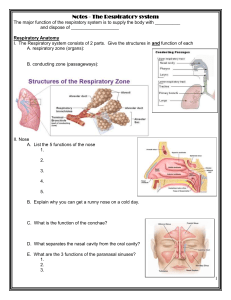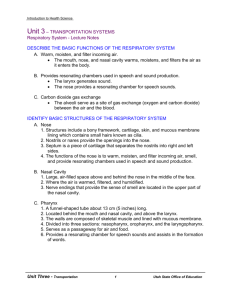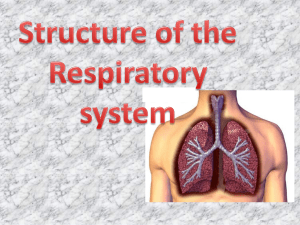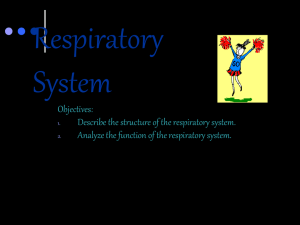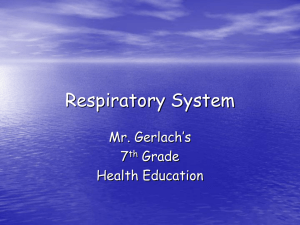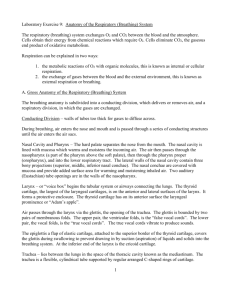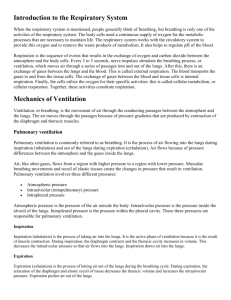Week 10_Lecture Notes_The Respiratory - TAFE-Cert-3
advertisement
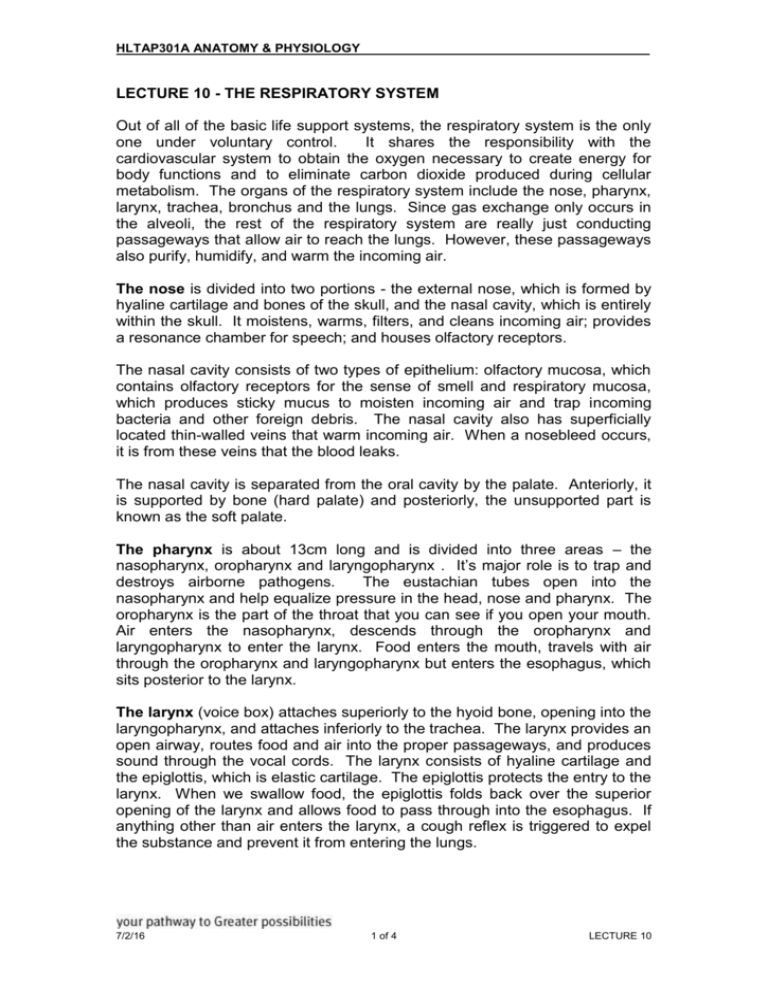
HLTAP301A ANATOMY & PHYSIOLOGY LECTURE 10 - THE RESPIRATORY SYSTEM Out of all of the basic life support systems, the respiratory system is the only one under voluntary control. It shares the responsibility with the cardiovascular system to obtain the oxygen necessary to create energy for body functions and to eliminate carbon dioxide produced during cellular metabolism. The organs of the respiratory system include the nose, pharynx, larynx, trachea, bronchus and the lungs. Since gas exchange only occurs in the alveoli, the rest of the respiratory system are really just conducting passageways that allow air to reach the lungs. However, these passageways also purify, humidify, and warm the incoming air. The nose is divided into two portions - the external nose, which is formed by hyaline cartilage and bones of the skull, and the nasal cavity, which is entirely within the skull. It moistens, warms, filters, and cleans incoming air; provides a resonance chamber for speech; and houses olfactory receptors. The nasal cavity consists of two types of epithelium: olfactory mucosa, which contains olfactory receptors for the sense of smell and respiratory mucosa, which produces sticky mucus to moisten incoming air and trap incoming bacteria and other foreign debris. The nasal cavity also has superficially located thin-walled veins that warm incoming air. When a nosebleed occurs, it is from these veins that the blood leaks. The nasal cavity is separated from the oral cavity by the palate. Anteriorly, it is supported by bone (hard palate) and posteriorly, the unsupported part is known as the soft palate. The pharynx is about 13cm long and is divided into three areas – the nasopharynx, oropharynx and laryngopharynx . It’s major role is to trap and destroys airborne pathogens. The eustachian tubes open into the nasopharynx and help equalize pressure in the head, nose and pharynx. The oropharynx is the part of the throat that you can see if you open your mouth. Air enters the nasopharynx, descends through the oropharynx and laryngopharynx to enter the larynx. Food enters the mouth, travels with air through the oropharynx and laryngopharynx but enters the esophagus, which sits posterior to the larynx. The larynx (voice box) attaches superiorly to the hyoid bone, opening into the laryngopharynx, and attaches inferiorly to the trachea. The larynx provides an open airway, routes food and air into the proper passageways, and produces sound through the vocal cords. The larynx consists of hyaline cartilage and the epiglottis, which is elastic cartilage. The epiglottis protects the entry to the larynx. When we swallow food, the epiglottis folds back over the superior opening of the larynx and allows food to pass through into the esophagus. If anything other than air enters the larynx, a cough reflex is triggered to expel the substance and prevent it from entering the lungs. 7/2/16 1 of 4 LECTURE 10 HLTAP301A ANATOMY & PHYSIOLOGY The trachea (windpipe) is about 10-12cm long and descends from the larynx through the neck into the mediastinum, where it terminates at the primary bronchi. The trachea is lined with ciliated mucosa that propels mucus that is loaded with dust particles towards the throat where it can be swallowed or spat out. The ‘C-shaped’ rings of hyaline cartilage of the trachea serve a double purpose. The open part abuts the esophagus and allows the esophagus to expand when swallowing a large piece of food. The solid portion of the ‘C’ supports the walls of the trachea and keeps it open, regardless of pressure changes that occur during breathing. The bronchi are a continuation of the structural framework of the trachea (except that they have more smooth muscle). They consist of right and left primary bronchi that enter each lung and diverge into secondary bronchi that serve each lobe of the lungs. The right bronchus is wider, shorter and straighter than the left. This makes it the more common bronchus for an inhaled foreign object to become lodged. Secondary bronchi branch into several orders of tertiary bronchi, which ultimately branch into bronchioles. As the conducting airways become smaller, the supportive cartilage changes in character until it is no longer present in the bronchioles. The respiratory zone begins as the terminal bronchioles feed into respiratory bronchioles that terminate in alveolar ducts within clusters of alveolar sacs, which consist of alveoli. The lungs occupy all of the thoracic cavity except for the mediastinum, which houses the heart, major blood vessels and the esophagus. Each lung is suspended within its own pleural cavity and connected to the mediastinum by vascular and bronchial attachments called the lung root. There are two circulations that serve the lungs: the pulmonary network carries systemic blood to the lungs for oxygenation, and the bronchial arteries provide systemic blood to the lung tissue. Lung tissue consists largely of air spaces, with the balance of lung tissue, its stroma, comprised mostly of elastic connective tissue. The pleurae form a thin, double-layered serosa. The parietal pleura lines the thoracic cavity. The visceral pleura covers the external lung surface, following its contours and fissures. The pleural membranes produce a slippery serous secretion, pleural fluid, which allows the lungs to glide over the thorax wall during breathing movements without friction. Pleurisy (inflammation of the pleura) can be caused by decreased secretion of pleural fluid whereby the pleural surfaces become dry and rough, resulting in friction and stabbing pain with each breath. 7/2/16 2 of 4 LECTURE 10 HLTAP301A ANATOMY & PHYSIOLOGY The major function of the respiratory system is to supply the body with oxygen and dispose of carbon dioxide. To do this, at least four distinct events must occur – these four events are collectively called respiration. The four events are pulmonary ventilation, external respiration, respiratory gas transport and internal respiration. Pulmonary Ventilation Pulmonary ventilation, more commonly known as breathing, is a mechanical process causing gas flow into and out of the lungs according to volume changes in the thoracic cavity. External respiration involves O2 uptake and CO2 unloading from hemoglobin in red blood cells. O2 diffuses rapidly from the alveoli (in the lungs) into the blood, and carbon dioxide moves in the opposite direction. The respiratory membrane is normally very thin, and presents a huge surface area for efficient gas exchange. Respiratory Gas Transport – is the transport of oxygen and carbon dioxide in the blood to/from the cells of the body. Oxygen binds to hemoglobin to be transported and carbon dioxide is dissolved as bicarbonate ions in the blood (70%) and some binds to hemoglobin, but at different sites to oxygen. Internal Respiration occurs in the capillaries to all cells in the body. The actual use of oxygen and production of carbon dioxide by the cells of the body is the cornerstone of all energy-producing chemical reactions in the body. Respiratory Adjustments During vigorous exercise, deeper and more vigorous respirations, (called hyperpnea), ensure that tissue demands for oxygen are met. Three neural factors contribute to the change in respiration: psychic stimuli, cortical stimulation of skeletal muscles and respiratory centers, and excitatory impulses to the respiratory areas from active muscles, tendons, and joints. At high altitude, acute mountain sickness (AMS) may result from a rapid transition from sea level to altitudes above 8000 feet. A long-term change from sea level to high altitudes results in acclimatization of the body, including an increase in ventilation rate, lower than normal hemoglobin saturation, and increased production of erythropoietin. 7/2/16 3 of 4 LECTURE 10 HLTAP301A ANATOMY & PHYSIOLOGY Homeostatic Imbalances of the Respiratory System Chronic obstructive pulmonary diseases (COPD) are seen in patients that have a history of smoking, and result in progressive dyspnea, coughing and frequent pulmonary infections, and respiratory failure. Obstructive emphysema is characterized by permanently enlarged alveoli and deterioration of alveolar walls. Chronic bronchitis results in excessive mucus production, as well as inflammation and fibrosis of the lower respiratory mucosa. Asthma is characterized by coughing, dyspnea, wheezing, and chest tightness, brought on by active inflammation of the airways. Tuberculosis (TB) is an infectious disease caused by the bacterium Mycobacterium tuberculosis and spread by coughing and inhalation. Lung Cancer Lung cancer is the most common type of malignancy, and is strongly correlated with smoking. Squamous cell carcinoma arises in the epithelium of the bronchi, forming masses that hollow out and bleed. Adenocarcinoma originates in peripheral lung areas and small cell carcinoma forms clusters within the mediastinum and rapidly metastasize. 7/2/16 4 of 4 LECTURE 10
